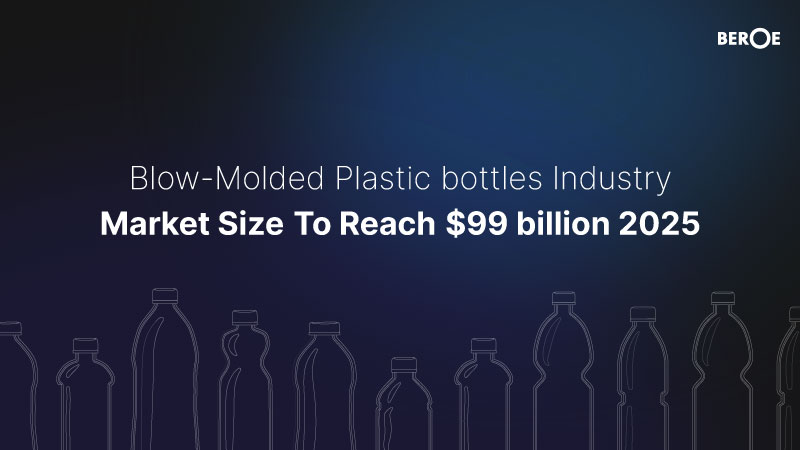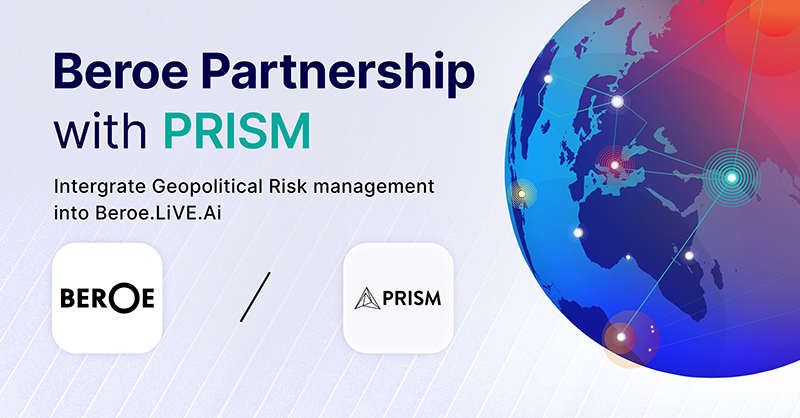Blow-Molded Plastic bottles Industry Market Size To Reach $99 billion 2025, says Beroe
Source: PR Newswire

Raleigh, NC, Dec 08 - The global market for blow-molded plastics was estimated to be worth $77–$78 billion in 2021. However, the COVID-19 pandemic has had a significant impact on the consumption of blow-molded plastics in important end-use groups, causing a decline of about 15-20% in 2020. In the next ten years, it is anticipated that bioplastics and bio-based resins will acquire increasing traction and eventually replace current crude-based plastic resins.
Nevertheless, the market recovered in 2021 and returned to growth, with a CAGR of 4-5 percent between 2021 and 2025, reaching roughly $98-$99 billion by 2025. The blow-molding process produces hollow plastic products, such as bottles and containers. This process is suited for mass production and is used in various industries, such as food and beverage, healthcare, personal care, and packaging.
The North American and Western European markets are the two major markets for blow-molded plastic bottles. These markets are expected to grow at a CAGR of 2–3 percent during the forecast period. The growth of these markets is driven by the increasing demand from the food and beverage, personal care, and pharmaceutical industries.
The Asia-Pacific region is the fastest-growing market for blow-molded plastic bottles and is expected to grow at a CAGR of 7–8 percent during the forecast period. The growth of this market is driven by the increasing demand from the food and beverage, personal care, and pharmaceutical industries in the region.
Many variables play a role in influencing the market, including:
Demographic factors, such as population growth and increased spending power of the lower middle classes in emerging regions, are contributing to the increased demand for consumer care products. This, in turn, is fueling demand for plastic bottles.
End-user demand is also playing a role in the growth of the plastic bottle market. Although beverages account for 45-50 percent of the market, the beauty and home care segments are also seeing steady growth. This is because most pet bottles applications have seasonal peaks, which drives change in the market.
The growing demand in emerging markets is also contributing to the growth of plastic packaging. Increasing middle-class segments are initiating increased consumption of FMCG and F&B products, driving the packaging market. APAC is expected to grow at a CAGR of 7-8 percent from 2020 to 2024 due to the demand for CSD and alcoholic drinks.
Ingress into Metal & Glass Containers Because of their reduced cost and weight, several significant industries, including personal care and processed food products, continue to shift away from metal and glass containers in favor of PET and HDPE bottles.
This trend has also been driven by plastic bottle sustainability rising as a result of advancements in bio-based resins and improved recycleability. Since resin suppliers are frequently prominent actors, backward integration is frequently not an option. Manufacturers of rigid plastic packaging products have limited integration options.
Due to greater market penetration, the dairy industry in Australia is anticipated to increase at a CAGR of roughly 4% over the next 5 years. This market is anticipated to be the primary engine of plastic bottle growth.
In the five years leading up to 2025, the blow-molded plastic bottle market in APAC is anticipated to expand at a CAGR of 7-8%. The personal care and beverage sectors will be the main drivers of the mature North American and Western European markets' predicted growth of 2% to 3%. Innovation & technical advancements in the plastic bottle manufacturing process will increase the production of these bottles.
The production of blow-molded plastic bottles has increased significantly in the last few years due to the advancement of technology and innovation in the manufacturing process. These bottles are now used in various industries, such as food and beverage, personal care, and pharmaceuticals. The plastic bottle suppliers market is expected to grow at a CAGR of 7–8 percent during the forecast period.
If looking at the long-term impact, the demand for luxury items such as cosmetics is expected to decline as consumers tighten their belts. This is not to say that the packaged goods industry will suffer as a whole – far from it. Many segments of the industry are expected to continue to grow, albeit at a slower pace than in recent years.
However, the slowdown in demand for luxury goods is likely to have a knock-on effect on the packaged goods sector as a whole. This is because processing packaged goods is a highly complex and resource-intensive process.
The catering sector is a crucial component of the hospitality industry and is vital to food and beverage services for businesses and individuals. Sustainability compliance is another important aspect of catering. This incorporates minimizing negative environmental impacts through low carbon emissions while conserving energy and natural resources. To be compliant with sustainability standards, catering businesses must have policies and procedures in place to reduce their impact on the environment.
Compliance with health and safety standards is also essential for the plastic market. This involves implementing safe workplace practices, such as providing secure access, clear passageways, internal traffic control, and good housekeeping inside catering premises.
The purity level measures the effectiveness of labor productivity and is calculated by dividing café sales by non-management hours worked in a defined period (usually a month). This is an important metric for the blow molded bottles industry to track as it can help to identify areas where labor productivity can be improved.
Volume consolidation is one of the critical negotiation levers used by buyers or Procurement Managers to reduce the number of suppliers and attain better leverage in negotiation. Converting the spot purchases to contracts is also a growing practice in blow-molding procurement.
There are many benefits to consolidating your volume with one or a few suppliers. The most obvious is that it gives more negotiating power when it comes time to renew or negotiate new contracts. By consolidating your volume, one becomes a more meaningful customer to your supplier, which gives one more leverage in price negotiations.
In addition, consolidating the volume can also help streamline your procurement process. Working with fewer suppliers can make it easier to manage your inventory, track spending, and keep the supply chain running smoothly.
By tracking essential catering KPIs and SLAs, businesses can ensure that they are providing a high level of service to their customers and meeting their needs and expectations. This, in turn, can help to build customer loyalty and repeat business.
About Beroe
Global supplier of analytics and insight for procurement, Beroe uses SaaS technology. We provide knowledge, data, and insights to help businesses source more wisely, which lowers costs, lowers risk, and increases profitability. For more than 15 years, Beroe has served as a reliable intelligence source, and it collaborates with 10,000 businesses globally, including 400 Fortune 500 firms. For more information, please visit https://www.beroeinc.com/.
Media Contact:
Rob McMurtrie
rob.mcmurtrie@beroe-inc.com
Related News
View all
Beroe Makes Strategic Investment in Forestreet, Strengthening AI Capabilities and Driving Procurement Intelligence Innovation

Beroe introduces on-demand geopolitical risk analysis through PRISM enabling C-Suite to protect against ongoing supply chain disruptions
